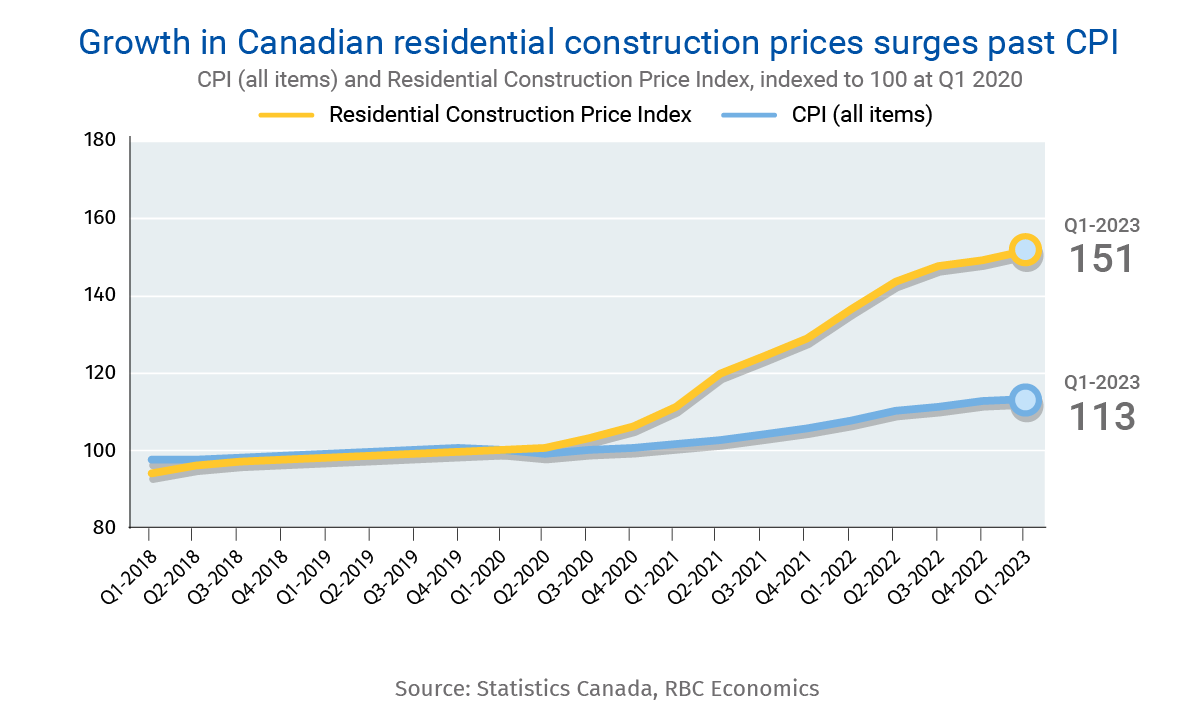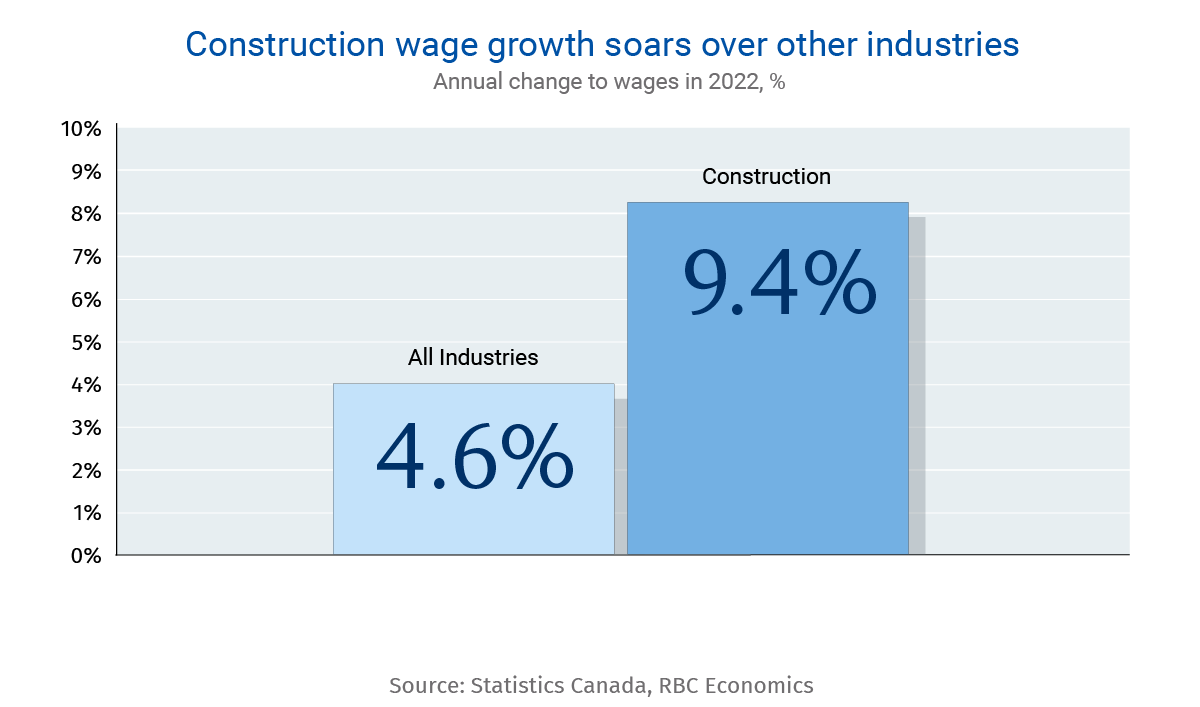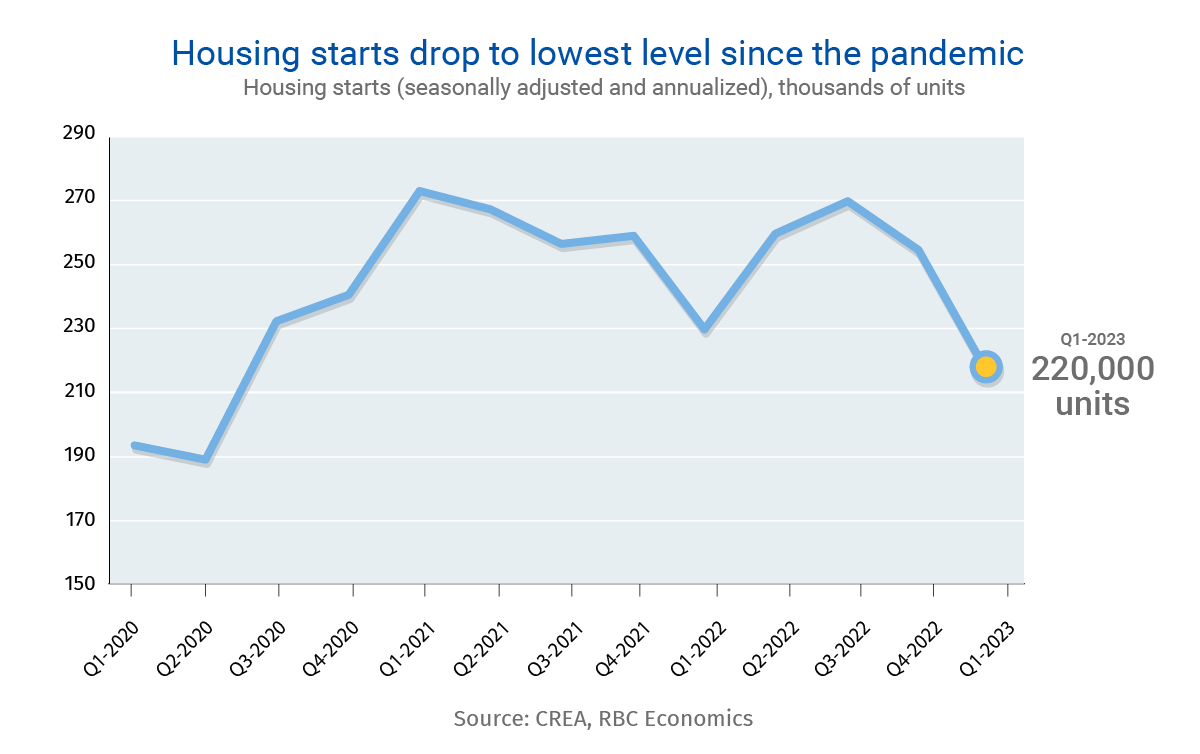- Canada’s residential construction price index has soared 51% since the start of the pandemic, putting new pressure on home prices amid a severe housing affordability crisis.
- A shortage of workers (particularly in the skilled trades), a stagnant supply of raw materials and increased input costs have all contributed to price growth.
- Development charges have also spiked alongside higher materials costs and increases in expected population growth.
- More housing starts are required to deliver a badly needed expansion in housing supply. But these will boost demand for materials, which will put upward pressure on costs once again.
- The bottom line: Longer-range problems will continue to challenge efforts to expand Canada’s housing stock. Amid construction material supply constraints, governments will need to keep policy in line with the broader goal of improving housing affordability.
Construction costs have gone through the roof
The cost of building a home in Canada—or any structure for that matter—has never been higher. Up 51% since the start of the pandemic (Q1 2020), the country’s residential construction price index has well outpaced CPI (+13%). Driving the increase are dramatic jumps in prices for key building materials like concrete and structural steel, up 55% and 53% respectively since the first quarter of 2020. Soaring lumber prices in 2021 and early 2022 also drove up costs but have since retreated.
This surge in raw material prices, together with a ballooning population, has also accelerated increases in the development fees and levies imposed by municipal governments. These fast-growing fees—which increased as much as 30% annually last year for single or semi-detached units—are indexed to Statistics Canada’s Construction Cost Index. Given they are intended to fund the growth component of municipal capital projects, high levels of expected population growth, alongside inflation, have contributed to the rapid acceleration of these fees.

Extreme weather, temporary shutdowns squeeze raw material supplies
Low interest rates and a rising population sent the development industry into a frenzy during the pandemic. But the fierce competition for raw materials wasn’t met with a rise in production. In fact, production of these critical goods declined between Q1 2020 and Q1 2023—with lumber production falling 11% and production of lime, a critical input for cement, dropping 20%. While several environmental challenges (including heavy rain, flooding, and wildfires) constrained lumber supply, temporary shutdowns of cement plants in Ontario, B.C. and Alberta have hampered production of cement.
But these aren’t the only challenges aggravating the construction industry. Higher input costs (such as fuel and transportation) have disrupted production, while robust demand and a shortage of workers have created serious imbalances in the jobs market. Labour costs have soared as high vacancy rates in construction exceed overall rates. High vacancy rates in construction jobs have exceeded overall vacancy rates since at least Q4 2020—and sent labour costs soaring. Wages in the sector grew 9.4% in 2022, nearly double the pace of other industries.

Longer-term issues will continue to challenge builders
Reining in construction costs to deliver more affordable and attainable housing won’t be easy. In the near-term, a lull in homebuilding and the resolution of production issues at cement plants are likely to ease the pressure to some degree. We expect housing starts to dip 10% this year across Canada, which should temporarily soften demand for materials.
But significantly ramping up homebuilding over the medium to longer term will keep costs elevated. Continuing to focus on higher-density development in very tall structures, for example, will push up demand for cement—potentially straining production capacity limits. And expanding capacity for cement—or other materials—may be difficult given the environmental impact this would have. Even expanding lumber production could be tricky because of climate change (and more frequent and devastating forest fires).
Excellent efforts have been made to address worker shortages through the launch of the express entry process for skilled trades newcomers and various provincial programs to attract Canadians into the construction trades. But it remains to be seen if they will succeed at curbing construction cost growth. While development fees and levies are intended to enable the growth of municipalities, governments need to be mindful of their impact on construction costs. Fees need to be consistent with the broader goal of improving the affordability of housing.

Robert Hogue is responsible for providing analysis and forecasts on the Canadian housing market and provincial economies. Robert holds a Master’s degree in economics from Queen’s University and a Bachelor’s degree from Université de Montréal. He joined RBC in 2008.
Rachel Battaglia is an economist at RBC. She is a member of the Macro and Regional Analysis Group, providing analysis for the provincial macroeconomic outlook.
Proof Point is edited by Naomi Powell, Managing Editor of RBC Economics & Thought Leadership.
This article is intended as general information only and is not to be relied upon as constituting legal, financial or other professional advice. The reader is solely liable for any use of the information contained in this document and Royal Bank of Canada (“RBC”) nor any of its affiliates nor any of their respective directors, officers, employees or agents shall be held responsible for any direct or indirect damages arising from the use of this document by the reader. A professional advisor should be consulted regarding your specific situation. Information presented is believed to be factual and up-to-date but we do not guarantee its accuracy and it should not be regarded as a complete analysis of the subjects discussed. All expressions of opinion reflect the judgment of the authors as of the date of publication and are subject to change. No endorsement of any third parties or their advice, opinions, information, products or services is expressly given or implied by Royal Bank of Canada or any of its affiliates. This document may contain forward-looking statements within the meaning of certain securities laws, which are subject to RBC’s caution regarding forward- looking statements. ESG (including climate) metrics, data and other information contained on this website are or may be based on assumptions, estimates and judgements. For cautionary statements relating to the information on this website, refer to the “Caution regarding forward-looking statements” and the “Important notice regarding this document” sections in our latest climate report or sustainability report, available at: https://www.rbc.com/community-social- impact/reporting-performance/index.html. Except as required by law, none of RBC nor any of its affiliates undertake to update any information in this document.


